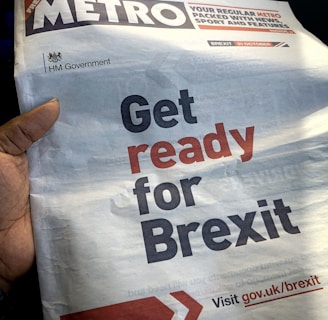Media and Psychological Warfare.
Psychological warfare involves using psychological tactics, propaganda, and manipulation to influence the thoughts, emotions, and behaviors of individuals or groups. It's often used in military, political, or social contexts to gain an advantage or control over an opponent by targeting their beliefs, perceptions, and decision-making processes. Media is a powerful tool utilized in psychological warfare due to its ability to reach and influence a wide audience.
COMMUNICATION
1/2/20243 min read


Media and Psychological Warfare.
Psychological warfare involves using psychological tactics, propaganda, and manipulation to influence the thoughts, emotions, and behaviors of individuals or groups. It's often used in military, political, or social contexts to gain an advantage or control over an opponent by targeting their beliefs, perceptions, and decision-making processes. This can include various strategies such as misinformation, intimidation, or the dissemination of persuasive messaging to achieve specific objectives.
The history of psychological warfare dates back centuries and has evolved alongside advancements in communication, technology, and social manipulation. It became more prominent during times of war, where influencing the morale of opposing forces or civilian populations was crucial. Some key aspects of its history and reasons behind its use include:
Military Context:
Psychological warfare has been utilized in conflicts throughout history to weaken the enemy's resolve, boost morale among friendly forces, and gain tactical advantages. This includes spreading rumors, using propaganda leaflets, broadcasting messages, or conducting covert operations to demoralize adversaries.
Political and Ideological Battles:
Governments and political entities have used psychological warfare to shape public opinion, control narratives, and influence elections. This involves tactics such as disinformation campaigns, manipulation of media, and psychological operations to sway public perception or undermine opposing viewpoints.
Social Control and Influence:
Psychological warfare techniques have been employed within societies to control populations, suppress dissent, or promote specific ideologies. This can involve censorship, propaganda, and the use of fear or intimidation to control behaviors and opinions.
Technological Advances:
With the advent of modern communication technologies, such as the internet and social media, psychological warfare has expanded its reach and impact. These platforms offer new ways to disseminate information rapidly, manipulate public opinion, and target specific demographics with tailored messages.
Media is a powerful tool utilized in psychological warfare due to its ability to reach and influence a wide audience. Various methods are employed:
Propaganda Dissemination:
Various media platforms, including TV, radio, newspapers, social media, and online publications, are utilized to spread biased or misleading information. This information aims to shape public opinion, manipulate perceptions, and support a particular narrative or ideology.
Disinformation:
Media platforms, including traditional outlets like newspapers, television, radio, and modern digital channels such as social media and the internet, are used to spread propaganda, disinformation, and strategic messages to target audiences. False or misleading information spread through media channels to confuse, mislead, or sow discord among the population.
Censorship:
Controlling or limiting access to certain information or viewpoints through media channels to control narratives or manipulate public understanding.
Psychological Operations (PSYOPS):
Media platforms are employed to conduct PSYOPS, delivering messages, images, or content aimed at influencing emotions, behaviors, or attitudes. These operations often target enemy populations or influence friendly ones to achieve strategic goals.
Reinforcing Beliefs:
Media propaganda tends to reinforce existing beliefs within targeted audiences, creating an echo chamber effect where individuals are repeatedly exposed to information that aligns with their preconceived notions.
Public Opinion Influence:
Psychological warfare aims to sway public opinion by controlling the narrative, altering perceptions, or reinforcing specific ideologies through media channels, thereby impacting decision-making processes.
Behavioral Influence:
Media employed in psychological warfare aims to influence behavior by shaping attitudes, altering beliefs, and encouraging or discouraging specific actions among the targeted audience.
Control of Narratives:
Through media channels, psychological warfare controls narratives, directing attention to certain issues while deflecting from others. This control influences public discourse and shapes collective understanding.
Social Media Influence:
Leveraging social media platforms, psychological warfare campaigns can amplify certain narratives, create divisiveness, or manipulate public opinion by spreading targeted messages or misinformation.
Creating Fear or Uncertainty:
Media can be used to spread alarming or intimidating content to instill fear or uncertainty among the population. This tactic aims to influence behaviors and decision-making processes.
Creating Division or Unity:
Media can be used to create division within populations or foster unity among certain groups. It strategically spreads content to polarize opinions or rally support for a particular cause, ideology, or entity.
Influencing Perception:
Media used in psychological warfare manipulates how people perceive information, events, and entities. It shapes narratives, frames stories, and selectively presents information to influence how individuals or groups interpret and understand various situations.
Emotional Manipulation:
Psychological warfare through media aims to evoke specific emotions strategically. It can exploit emotions like fear, anger, or solidarity to sway opinions, influence behaviors, and provoke desired reactions.
Undermining Adversaries:
Media in psychological warfare targets adversaries by attempting to undermine their morale, credibility, or support base. It aims to weaken their resolve or sow doubt among their ranks.
Summary:
The reasons behind employing psychological warfare are varied and can include gaining a strategic advantage, achieving military objectives, controlling narratives, shaping public opinion, destabilizing adversaries, or maintaining social and political control. It's a tool used to influence the psychological and emotional aspects of individuals or groups, thereby impacting their decision-making processes and behaviors in pursuit of specific goals or outcomes.
© 2025 Copyright Amna Sadaf
